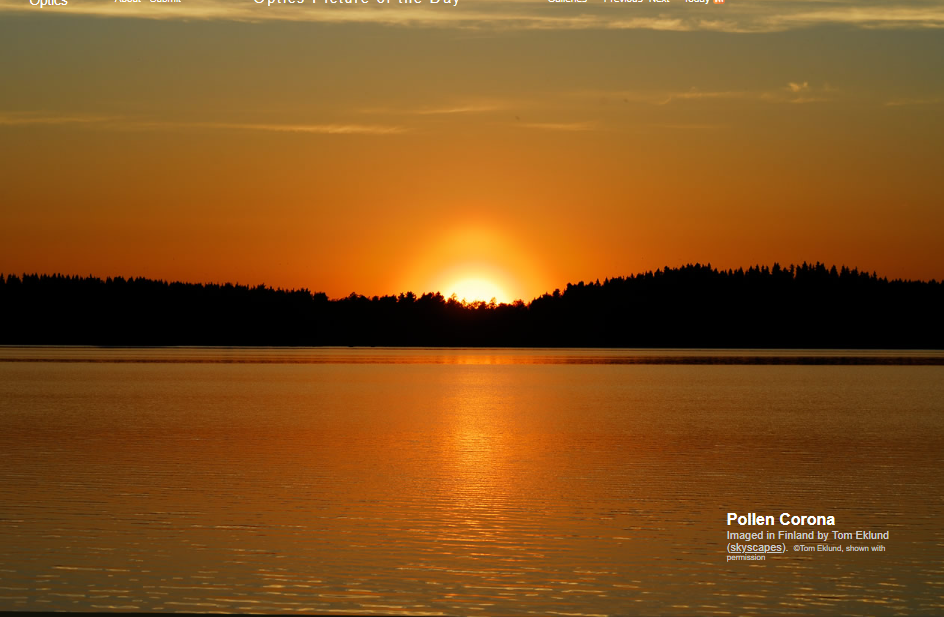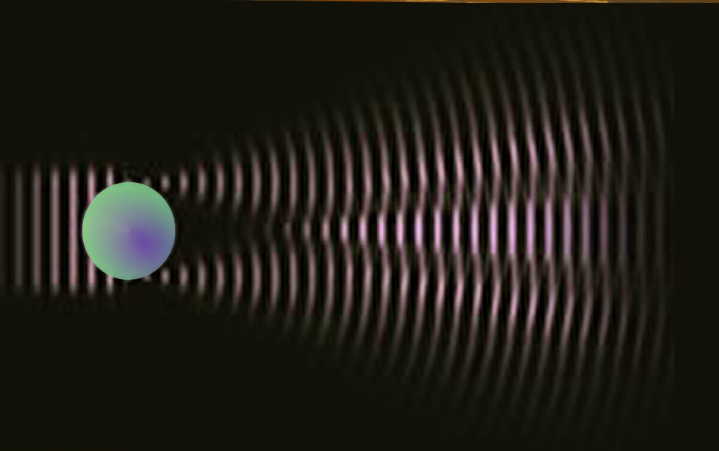OPOD -Changing Angles
OPOD - Changing Angles: Exploring the Phenomenon of Pollen Coronas
Have you ever noticed a distinct ring encircling the bright aureole around the sun, accompanied by a brightening at the top? This captivating atmospheric phenomenon is known as a pollen corona. Originating from Finland, Tom Eklund (skyscapes) captured an exquisite image of a pollen corona, showcasing its remarkable features. In this article, we will delve into the fascinating world of pollen coronas, exploring their formation and the role played by pollen particles in creating these ethereal optical displays.
The Science Behind Pollen Coronas
Pollen particles, suspended in the air, possess the ability to scatter light waves that impinge upon their surfaces. As light interacts with these particles, spherical waves emanate from each point on their surface. The interaction between these waves results in regions of bright and dark light. When wave crests coincide, they produce areas of bright light, while regions where crests cancel each other out appear dark. The collective effect of millions of pollen grains in the atmosphere gives rise to a circular diffraction or interference pattern, which manifests as a corona.
The Intriguing Characteristics of Pollen Coronas
One of the distinctive features of pollen coronas is their non-spherical shape. As pollen grains are transported through the air by wind currents, they become aerodynamically oriented. This orientation causes their coronae to exhibit an oval shape, with bright spots along the rings. By studying these bright spots, scientists can gain insights into the unique properties of pollen particles and their behavior in the atmosphere.
Unraveling the Complexities of Pollen Coronas
While pollen coronas offer a captivating spectacle, it is important to exercise caution when interpreting their presence. Digital cameras, when capturing images of the setting sun, can sometimes produce corona-like artifacts. These artifacts may resemble pollen coronas, but they are not true representations of this atmospheric phenomenon. Therefore, it is crucial to discern between genuine pollen coronas and camera-induced artifacts.
Exploring the Wonders of Atmospheric Optics
Pollen coronas are just one example of the many captivating optical phenomena that occur in our atmosphere. From rainbows and halos to mirages and iridescence, our skies are filled with an array of mesmerizing displays. These phenomena are a testament to the intricate interplay between light, particles, and atmospheric conditions. By studying these optical wonders, scientists can gain a deeper understanding of the physics and dynamics of our atmosphere.
Capturing the Beauty of Pollen Coronas
Photographers and sky enthusiasts around the world have been captivated by the allure of pollen coronas. The intricate patterns and ethereal beauty of these optical displays make them a popular subject for artistic exploration. Capturing the delicate details of a pollen corona requires patience, skill, and an understanding of atmospheric optics. By employing specialized techniques and equipment, photographers can immortalize the ephemeral beauty of these natural phenomena.
Conclusion
Pollen coronas are a captivating manifestation of atmospheric optics, arising from the scattering of light by pollen particles suspended in the air. The non-spherical shape of pollen grains, coupled with their aerodynamic orientation, gives rise to oval-shaped coronae with bright spots along the rings. While digital cameras can produce corona-like artifacts, genuine pollen coronas exhibit distinct features that set them apart. By delving into the intricacies of pollen coronas, we gain a deeper appreciation for the wonders that unfold in our atmosphere. So, keep your eyes to the sky and marvel at the ever-changing angles that reveal the hidden beauty of our world.

Pollen Corona
Imaged in Finland by Tom Eklund (skyscapes). ©Tom Eklund, shown with permission

The pollen corona is recognisable by a definite ring outside the bright central aureole around the sun and the brightening at the ring’s top. There is a hint too of a second outer ring. Care is needed in interpretation because digital cameras can give corona-like artifacts around the setting sun.
Pollen particles scatter light waves from their surface. Each point on the surface is a source of outgoing spherical waves. The waves interact with each other. In directions where wave crests coincide there is bright light. Where the crests cancel there is darkness. The result in the sky from millions of pollen grains is a circular diffraction or interference pattern – a corona.
Pollen grains are non-spherical and become aerodynamically oriented as they drift in the wind. The oriented non-spherical shape causes their coronae to be oval with bright spots on the rings.

Note: this article has been automatically converted from the old site and may not appear as intended. You can find the original article here.
Reference Atmospheric Optics
If you use any of the definitions, information, or data presented on Atmospheric Optics, please copy the link or reference below to properly credit us as the reference source. Thank you!
-
<a href="https://atoptics.co.uk/blog/opod-changing-angles/">OPOD -Changing Angles</a>
-
"OPOD -Changing Angles". Atmospheric Optics. Accessed on November 26, 2024. https://atoptics.co.uk/blog/opod-changing-angles/.
-
"OPOD -Changing Angles". Atmospheric Optics, https://atoptics.co.uk/blog/opod-changing-angles/. Accessed 26 November, 2024
-
OPOD -Changing Angles. Atmospheric Optics. Retrieved from https://atoptics.co.uk/blog/opod-changing-angles/.